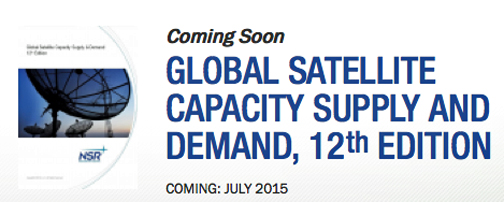[SatNews] NSR’s Global Satellite Capacity Supply & Demand, 12th Edition report, just released, projects demand for more than 7,700 transponders of traditional C-, Ku-, and wide beam Ka-band FSS capacity globally by 2024.
NSR also forecasts more than 3 Terabits of GEO-HTS, MEO-HTS, and LEO-HTS bandwidth demand, across a series of applications ranging from data to broadband access to mobility. With growth slowing and prices declining in traditional FSS markets, NSR expects a CAGR of less than 2 percent for traditional FSS demand; new markets will therefore need to be tapped and new possibilities unlocked through increased bandwidth efficiencies and lower cost per bit in order to fuel organic market expansion.
From a supply perspective, NSR expects C-band additions to slow to under 100 transponders annually in the next few years. Ku-band supply, on the back of video applications, will see more than 1,700 transponders added cumulatively by the end of the decade, but slow down thereafter. Most operators have leapfrogged to Ka-band GEO-HTS where there is enough spectrum, and tens of Gigabits are being added every year.
From a demand perspective, traditional FSS markets will provide solid cash flow due to legacy contracts, while organic demand is expected to be fairly weak at around 1.7 percent per year. This corresponds to just over 1,200 transponders of new demand for C-, Ku-, and wide beam Ka-band capacity annual growth until 2024. GEO-HTS applications will see formidable demand gains of nearly 25 percent annually, but the biggest wildcard will certainly be the launch of a potential LEO-HTS constellation.
The 12th Edition of NSR’s Global Satellite Capacity Supply & Demand study continues more than a decade of in-depth and highly detailed assessments of commercial satellite capacity supply and demand analysis, as well as introducing many industry firsts, such as this year’s inclusion of HTS capacity split by frequency band, Non GEO-HTS constellation analysis, and complete coverage of the High Throughput Satellite market for which NSR has pioneered research efforts for half a decade.
Executive Comments
“More than 2.7 Terabits of GEO-HTS supply will be available by 2024, of which more than 80 percent will be Ka-band,” said Prashant Butani, Senior Analyst at NSR and co-author of the report. “In a few years, HTS will be to data traffic what widebeam Ku-band is to video applications today – the workhorse bandwidth with growing competition lowering the cost of access.” Non-GEO HTS systems are limited to MEO today, but NSR expects that even if one or two LEO constellations deploy, there would be Terabits of supply flooding the market at a much lower price per bit.
“GEO-HTS will definitely present opportunities. With all investment by the big players going into GEO-HTS systems, we expect over 1.5 Tbps of GEO-HTS demand by 2024, with 20% of demand coming from much higher-margin “non-Broadband” applications”, says Blaine Curcio, Senior Analyst and report co-author. “That said, there is potential for significant market disruptions moving forward, particularly after the 2018/2019 timeframe.” Overall, the study finds that despite flat to falling prices for capacity, the industry will “expand the pie” of addressable demand and propel 4% revenue growth per year to 2024.


